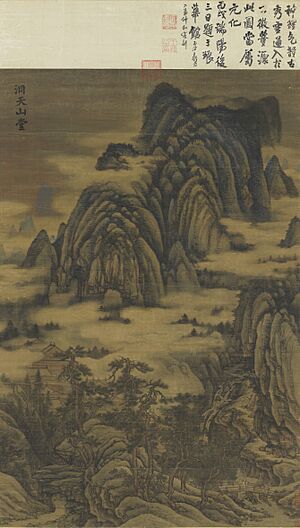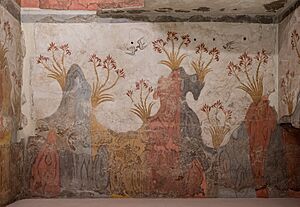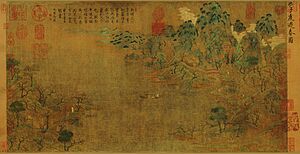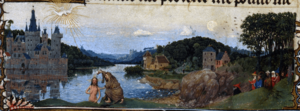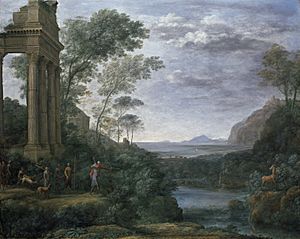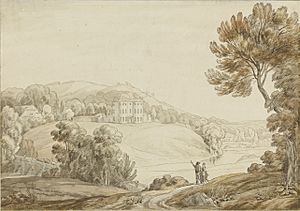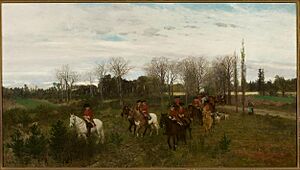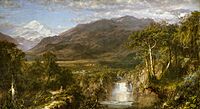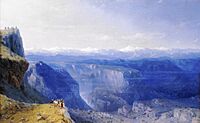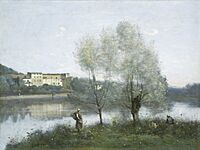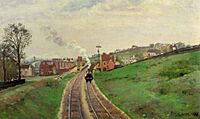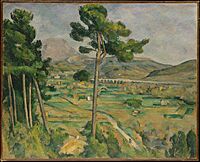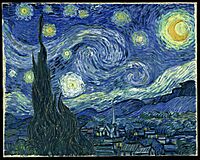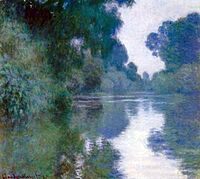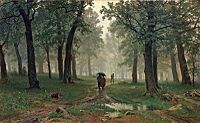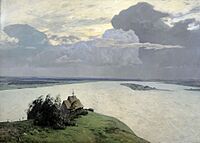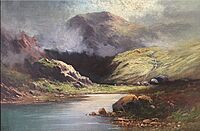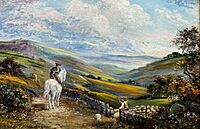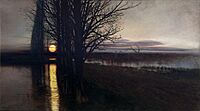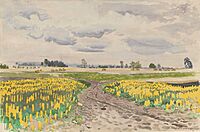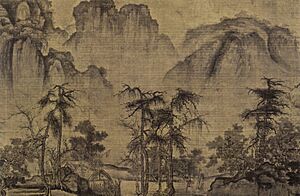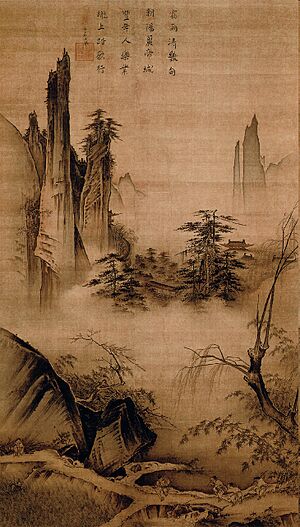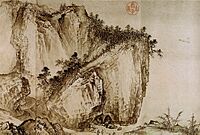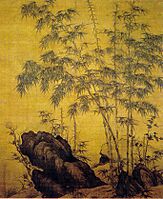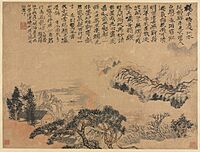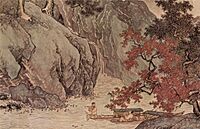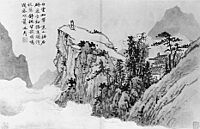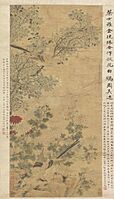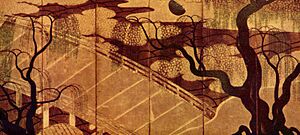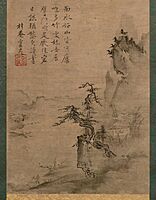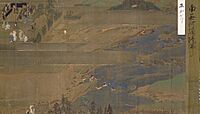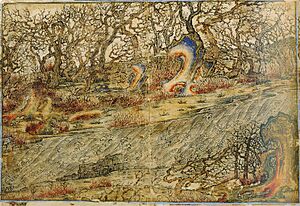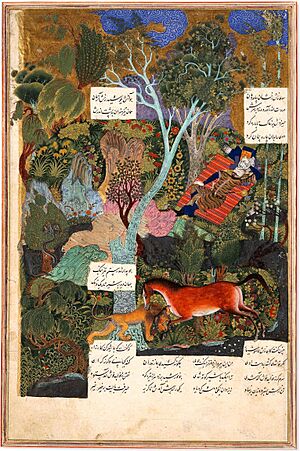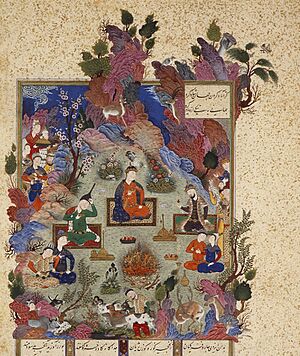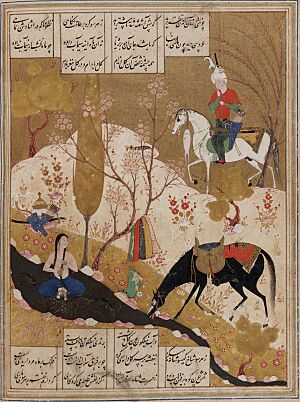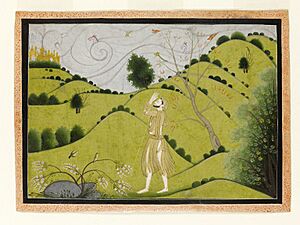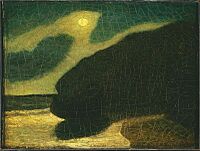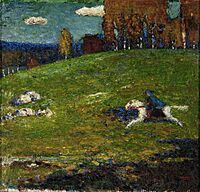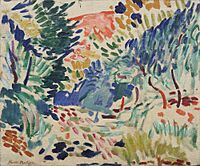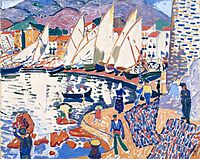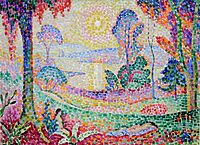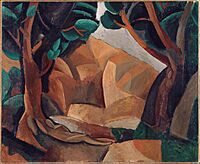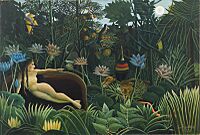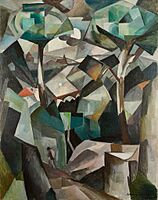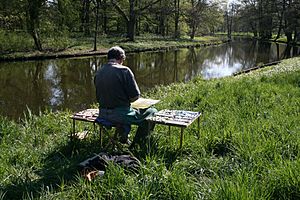Landscape painting facts for kids
Landscape painting, also called landscape art, is a type of painting. It shows natural scenes like mountains, valleys, rivers, and trees. The main idea is to capture a wide view of nature. Artists arrange these natural elements into a pleasing picture. Sometimes, landscapes are backgrounds for people or animals. The sky is almost always part of the view. Weather, like clouds or sunshine, often adds to the scene.
This art form has deep roots in both Western and Chinese cultures. Both traditions are over a thousand years old. In East Asia, landscape art often has a spiritual meaning. This comes from ideas like Daoism. In the West, this spiritual connection became clear with the Romantic movement.
Artists can paint landscapes from their imagination. They can also copy real places. If a painting shows a specific, real place, especially with buildings, it's called a topographical view. These views were very popular as prints. However, they were sometimes seen as less important than imagined landscapes. This was true in both Western and Chinese art.
The word "landscape" came into English from the Dutch word landschap. It first appeared around the 17th century. At first, it only meant a work of art. Later, it was used to describe real views and scenes in poetry.



Contents
- Exploring Landscape Art Through Time
- Artistic Techniques in Landscape Painting
- Different Kinds of "Scapes" in Art
- Landscape Art in Modern Times
- Famous Landscape Art Movements
- See also
Exploring Landscape Art Through Time
Ancient Beginnings of Landscape Art
The very first artworks didn't focus much on landscapes. They might show a ground line or a few trees. But true landscape art, without people, appeared around 1500 BCE. These were frescoes from the Minoan civilization. Ancient Egyptian art also showed natural settings. However, it focused more on individual plants and animals.
Ancient Romans created many landscapes. These were often frescoes decorating rooms. You can still see them in places like Pompeii. These Roman paintings often showed grand, imaginary scenes. They featured mountains, seas, and rivers.
Western Landscape Traditions
Medieval Times: Nature's Return
After the Roman Empire, landscape art almost disappeared in the West. It was kept alive mainly in copies of older works. Interest in nature slowly returned in the 14th century. Artists like Giotto di Bondone started adding natural backgrounds to their paintings.
By the 15th century, landscape painting became a recognized art form in Europe. It often served as a background for religious stories. For example, scenes like the "Rest on the Flight into Egypt" showed beautiful natural settings. Detailed landscapes also appeared in fancy illuminated manuscripts.
Renaissance: New Views and Ideas


During the Renaissance, artists became very skilled at painting landscapes. Around the early 1500s, artists like Albrecht Altdorfer created some of the first "pure landscapes." These paintings focused only on nature, with no people.
In the Netherlands, Joachim Patinir developed the "world landscape" style. These were huge, panoramic views with tiny figures. This style was very popular for about a hundred years. Artists also started to idealize landscapes. They often showed peaceful, countryside scenes inspired by old poems.
17th and 18th Centuries: Growth and Specialization

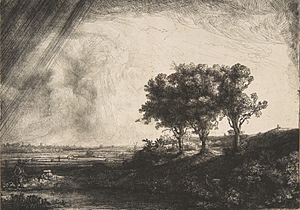
The 17th century was a golden age for landscape painting in the Netherlands. Many artists specialized in this genre. They developed amazing techniques to show light and weather. Dutch landscapes were often smaller, made for homes.
French artists like Claude Lorrain also became famous. They painted classical or biblical scenes set in grand landscapes. In England, landscape painting grew in popularity. Artists like John Robert Cozens and John Constable became well-known. Watercolour painting, especially of landscapes, became an English specialty.
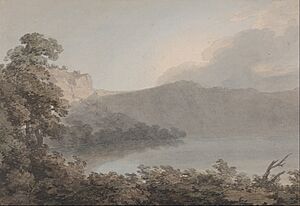
19th and 20th Centuries: Romanticism and Modern Art
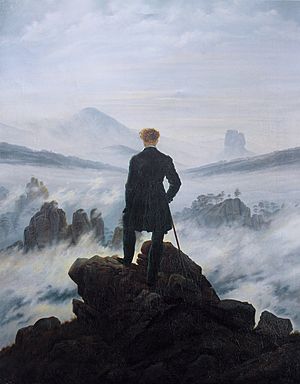
The Romantic movement in the 19th century made landscape art even more popular. Artists like Caspar David Friedrich painted wild and dramatic scenes. In France, the Barbizon School and later the Impressionists changed landscape painting forever. They focused on capturing light and atmosphere.
In the United States, the Hudson River School created huge paintings. They wanted to show the grand scale of American landscapes. Artists like Thomas Cole and Frederic Edwin Church were famous for this. Even after World War I, many important artists continued to paint landscapes. They used a wide variety of styles, from realistic to abstract.
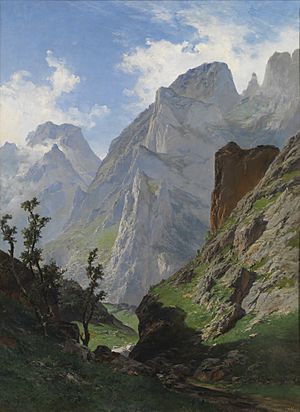
Gallery of Western Landscapes
-
The Hay Wain by John Constable (1821).
-
The Park at Petworth House by Joseph Mallord William Turner (around 1830).
-
The Heart of the Andes by Frederic Edwin Church (1859).
-
The Caucasus by Ivan Aivazovsky (1863).
-
Ville d'Avray by Jean-Baptiste-Camille Corot (around 1867).
-
Lordship Lane Station by Camille Pissarro (around 1870).
-
Mont Sainte-Victoire by Paul Cézanne (1882–1885).
-
The Starry Night by Vincent van Gogh (1889).
-
Branch of the Seine near Giverny by Claude Monet (1897).
-
Rain in an Oak Forest by Ivan Shishkin (1891).
-
Above Eternal Peace by Isaac Levitan (1894).
East Asian Landscape Art
China's "Mountain-Water" Art
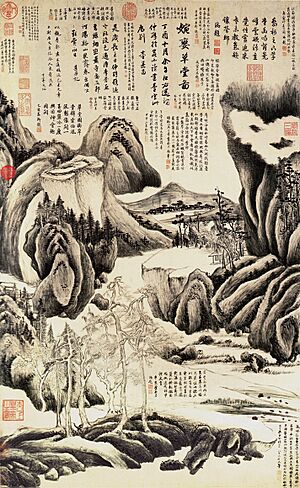
Chinese landscape painting is considered a huge contribution to world art. It's deeply connected to Taoism. These paintings often show imaginary mountains and rivers. They are meant to inspire deep thought and feeling.
Early Chinese art had landscape backgrounds. But the "pure landscape" style, with few or no figures, became popular around the 10th century. Artists often added their own poems and seals to these works. Chinese gardens also developed a beautiful style. They often included "viewing stones" – naturally shaped rocks that looked like tiny mountains.
Gallery of Chinese Landscapes
-
Travellers among Mountains and Streams by Fan Kuan (11th century).
-
Detail from Pure and Remote View of Streams and Mountains by Xia Gui (13th century).
-
A Fisher in Autumn by Tang Yin (1523 AD).
-
Pine Pavilion Near a Spring by Shitao (1675).
Japan's Narrative Landscapes
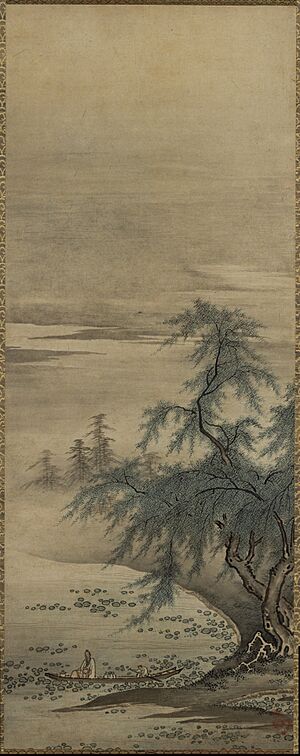
Japanese art often adapted Chinese styles. But Japanese artists focused more on storytelling. Their long scrolls, like those for the Tale of Genji, showed scenes in landscapes. These often included palace or city views.
Later, from the 15th century, more pure landscape paintings appeared. Many Zen Buddhist monks created monochrome ink paintings. They used brushstrokes to show mountains and nature. The ukiyo-e style, famous for woodblock prints, also developed landscape art. Artists like Hokusai and Hiroshige created iconic Japanese landscapes.
Gallery of Japanese Landscapes
-
Zhou Maoshu Appreciating Lotuses by Kanō Masanobu (15th century).
Persian and Indian Landscapes
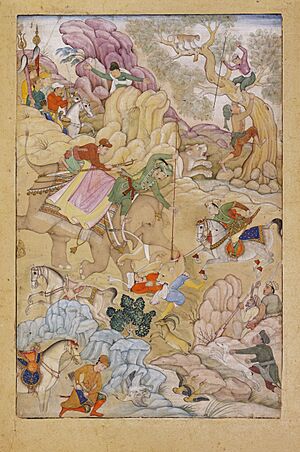
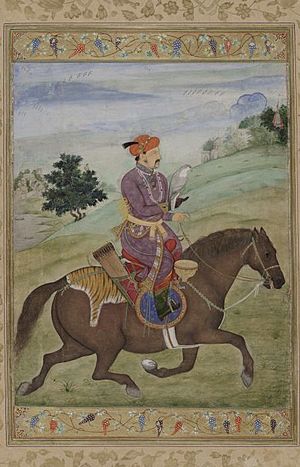
Persian miniature paintings began to include landscapes around the 14th century. These often showed rocky mountains filled with plants and animals. The artists used a high viewpoint. This allowed them to fill the picture with detailed natural scenes.
Indian painting also featured lush natural settings. Mughal painting combined Persian and Indian styles. Royal hunt scenes often showed wide landscapes. Paintings of monsoon rains, with dark clouds and lightning, were also popular.
Artistic Techniques in Landscape Painting

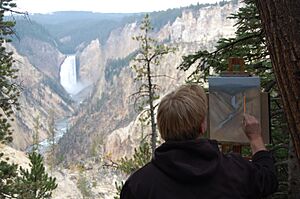
Many early landscapes were imagined by artists. But some, like city views, tried to show real places. Artists used clever tricks to make their imagined landscapes look natural. For example, some copied rough rocks to create mountain shapes. Others, like Degas, even used crumpled handkerchiefs to get ideas for clouds!
Painting outdoors, or en plein air, became popular later on. This was especially true after the 1870s. That's when ready-mixed oil paints in tubes became available. Portable easels also made it easier for artists to paint outside.
In many landscapes, mountains form a backdrop. Early artists didn't always show much sky. Chinese artists often used mist or clouds between mountains. They also showed clouds in the sky earlier than Western artists. Western art often used gold or patterned skies until around 1400. Later, plain blue skies became common.
Chinese landscape painting often uses ink on silk or paper. Artists focus on individual brushstrokes. These strokes create textures, like the "wrinkles" on mountains. Western watercolour painting uses different shades of color.
Different Kinds of "Scapes" in Art

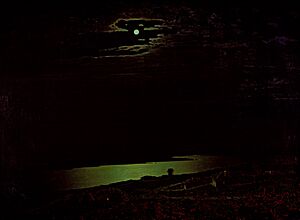
While we usually think of Earth's surface, there are many other types of "landscapes" in art:
- Skyscapes or Cloudscapes: Paintings of clouds, weather, and the sky.
- Moonscapes: Art showing the surface of a moon.
- Seascapes: Depictions of oceans, seas, or beaches.
- Riverscapes: Art featuring rivers or creeks.
- Cityscapes or Townscapes: Paintings of cities and urban areas.
- Aerial landscapes: Views of the ground from high above, like from an airplane.
- Vedute: An Italian word for "view," often used for detailed cityscapes.
- Landscape photography: Photos that capture natural scenery.
Landscape Art in Modern Times
Landscape painting continued to be important in the 20th century. Artists explored new styles and ways to show nature. They moved beyond traditional realism. This led to exciting new movements in art.
-
Albert Pinkham Ryder, Seacoast in Moonlight, 1890.
-
Wassily Kandinsky, Der Blaue Reiter, 1903.
-
Henri Matisse, Landscape at Collioure, 1905.
-
André Derain, Le séchage des voiles (The Drying Sails), 1905.
-
Pablo Picasso, Paysage aux deux figures (Landscape with Two Figures), 1908.
-
Henri Rousseau, The Dream, 1910.
-
Albert Gleizes, Le Chemin, Paysage à Meudon, Paysage avec personnage, 1911.
Famous Landscape Art Movements

Many art groups and styles have focused on landscapes throughout history. Here are some important ones:
East Asian Movements
- Southern School (China, 8th–16th centuries)
- Four Masters of the Yuan Dynasty (China)
- Kanō school (Japan, 15th–19th centuries)
- Nanga (Japan, 17th–19th centuries)
Western Movements
- Danube School (Germany, 16th century)
- Barbizon School (France, 19th century)
- Hudson River School (United States, 19th century)
- Impressionism (France, late 19th century)
- Post-Impressionism (late 19th – early 20th century)
- Fauvism (early 20th century)
- Group of Seven (Canada, 20th century)
- Land art (late 20th century)
See also
- Claude glass
- Landscape architecture
- Vädersolstavlan
- Visual arts
- Skyscraper


